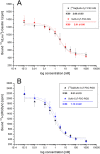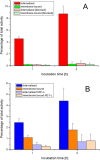Developing Targeted Hybrid Imaging Probes by Chelator Scaffolding
- PMID: 28462989
- PMCID: PMC5481817
- DOI: 10.1021/acs.bioconjchem.7b00182
Developing Targeted Hybrid Imaging Probes by Chelator Scaffolding
Abstract
Positron emission tomography (PET) as well as optical imaging (OI) with peptide receptor targeting probes have proven their value for oncological applications but also show restrictions depending on the clinical field of interest. Therefore, the combination of both methods, particularly in a single molecule, could improve versatility in clinical routine. This proof of principle study aims to show that a chelator, Fusarinine C (FSC), can be utilized as scaffold for novel dimeric dual-modality imaging agents. Two targeting vectors (a minigastrin analogue (MG11) targeting cholecystokinin-2 receptor overexpression (CCK2R) or integrin αVβ3 targeting cyclic pentapeptides (RGD)) and a near-infrared fluorophore (Sulfo-Cyanine7) were conjugated to FSC. The probes were efficiently labeled with gallium-68 and in vitro experiments including determination of logD, stability, protein binding, cell binding, internalization, and biodistribution studies as well as in vivo micro-PET/CT and optical imaging in U-87MG αVβ3- and A431-CCK2R expressing tumor xenografted mice were carried out. Novel bioconjugates showed high receptor affinity and highly specific targeting properties at both receptors. Ex vivo biodistribution and micro-PET/CT imaging studies revealed specific tumor uptake accompanied by slow blood clearance and retention in nontargeted tissues (spleen, liver, and kidneys) leading to visualization of tumors at early (30 to 120 min p.i.). Excellent contrast in corresponding optical imaging studies was achieved especially at delayed time points (24 to 72 h p.i.). Our findings show the proof of principle of chelator scaffolding for hybrid imaging agents and demonstrate FSC being a suitable bifunctional chelator for this approach. Improvements to fine-tune pharmacokinetics are needed to translate this into a clinical setting.
Conflict of interest statement
The authors declare no competing financial interest.
Figures






Similar articles
-
Exploiting the Concept of Multivalency with 68Ga- and 89Zr-Labelled Fusarinine C-Minigastrin Bioconjugates for Targeting CCK2R Expression.Contrast Media Mol Imaging. 2018 Apr 10;2018:3171794. doi: 10.1155/2018/3171794. eCollection 2018. Contrast Media Mol Imaging. 2018. PMID: 29849512 Free PMC article.
-
[(68)Ga]FSC-(RGD)3 a trimeric RGD peptide for imaging αvβ3 integrin expression based on a novel siderophore derived chelating scaffold-synthesis and evaluation.Nucl Med Biol. 2015 Feb;42(2):115-22. doi: 10.1016/j.nucmedbio.2014.10.001. Epub 2014 Oct 13. Nucl Med Biol. 2015. PMID: 25459110 Free PMC article.
-
Multimerization results in formation of re-bindable metabolites: A proof of concept study with FSC-based minigastrin imaging probes targeting CCK2R expression.PLoS One. 2018 Jul 30;13(7):e0201224. doi: 10.1371/journal.pone.0201224. eCollection 2018. PLoS One. 2018. PMID: 30059514 Free PMC article.
-
Molecular Imaging of Breast Cancer: Role of RGD Peptides.Mini Rev Med Chem. 2015;15(13):1073-94. doi: 10.2174/1389557515666150909144606. Mini Rev Med Chem. 2015. PMID: 26349490 Review.
-
111In/68Ga-Labeled DOTA-conjugated cyclo[γ-d-Glu-Ala-Tyr-d-Lys]-Trp-Met-Asp-Phe-NH2 (cyclo-MG1), a minigastrin analog.2012 May 17 [updated 2012 Jul 12]. In: Molecular Imaging and Contrast Agent Database (MICAD) [Internet]. Bethesda (MD): National Center for Biotechnology Information (US); 2004–2013. 2012 May 17 [updated 2012 Jul 12]. In: Molecular Imaging and Contrast Agent Database (MICAD) [Internet]. Bethesda (MD): National Center for Biotechnology Information (US); 2004–2013. PMID: 22787691 Free Books & Documents. Review.
Cited by
-
New Developments in Dual-Labeled Molecular Imaging Agents.J Nucl Med. 2019 Apr;60(4):459-465. doi: 10.2967/jnumed.118.213488. Epub 2019 Feb 7. J Nucl Med. 2019. PMID: 30733318 Free PMC article. Review.
-
Hybrid Imaging of Aspergillus fumigatus Pulmonary Infection with Fluorescent, 68Ga-Labelled Siderophores.Biomolecules. 2020 Jan 22;10(2):168. doi: 10.3390/biom10020168. Biomolecules. 2020. PMID: 31979017 Free PMC article.
-
Exploiting the Concept of Multivalency with 68Ga- and 89Zr-Labelled Fusarinine C-Minigastrin Bioconjugates for Targeting CCK2R Expression.Contrast Media Mol Imaging. 2018 Apr 10;2018:3171794. doi: 10.1155/2018/3171794. eCollection 2018. Contrast Media Mol Imaging. 2018. PMID: 29849512 Free PMC article.
-
Targeted Dual-Modal PET/SPECT-NIR Imaging: From Building Blocks and Construction Strategies to Applications.Cancers (Basel). 2022 Mar 23;14(7):1619. doi: 10.3390/cancers14071619. Cancers (Basel). 2022. PMID: 35406390 Free PMC article. Review.
-
Pretargeted Imaging with Gallium-68-Improving the Binding Capability by Increasing the Number of Tetrazine Motifs.Pharmaceuticals (Basel). 2018 Oct 11;11(4):102. doi: 10.3390/ph11040102. Pharmaceuticals (Basel). 2018. PMID: 30314332 Free PMC article.
References
Publication types
MeSH terms
Substances
Grants and funding
LinkOut - more resources
Full Text Sources
Other Literature Sources

